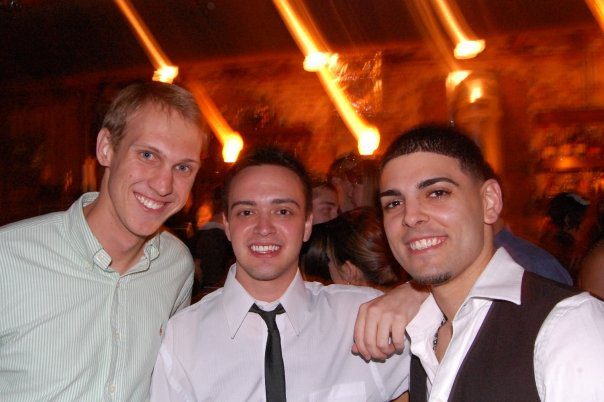Monday, January 1, 2024
By Joey Mazzaferro

While David A. Capablanca (BDES ’09) is the picture of success in today’s world of short-selling stocks, his path to this point wasn’t as smooth as he makes it look. He is open and honest about his winding road that led him from architecture to his role as a financial trader and founder at Friendly Bear University.
Capablanca started his architectural journey as an undergraduate student at the University of Florida School of Architecture. He was immersed in an intense studio culture environment, which helped him get the best results for his architecture projects. They were well thought out and done with meticulous rigor.
After he graduated from the UF College of Design, Construction and Planning, he went to UCLA for graduate school. During his first quarter there, he was diagnosed with a brain tumor and had to undergo emergency brain surgery.
“Surviving the brain tumor changed my perspective on life as I overheard the brain surgeon telling my mother that he extended my life by 50 years,” Capablanca said. “Once I heard that, my perspective on everything had changed. I had a sense of extreme urgency with everything I did.”
Despite his health issues, Capablanca completed his coursework as a part-time student and graduated from UCLA with a master’s degree. He went to work for an architecture firm in Los Angeles but encountered financial difficulties when he had to start repaying his student loans, which he didn’t have at UF thanks to in-state tuition rates.
“I realized I would be in debt until I retired since I was out of state when I took the loans and my schooling had been extended because of my brain operation,” Capablanca said. “As a result of the financial mess I was in, I started to look at other career fields with higher income, such as real estate, and I happened to find stock trading.”
In 2017, Capablanca did an intense amount of research into short selling stocks and signed up for online courses. Short selling stocks is when one borrows stock they feel will decline in price from a broker. That stock is sold with the hope it can be repurchased later at a lower price. The stock is then given back to its original owner and the short seller keeps the difference in price for profit.
“I was learning how to spot and short sell pump-and-dump stocks and was focused solely on learning,” Capablanca said. “I did not expect to make money while in the learning phase, just like when I was in college at UF, living in the dorms and working in the studio day and night with many of those nights being all-nighters. I pictured myself at UF again, learning from my studio professors and then dedicating myself to apply what I have learned into my projects with a long-term goal of becoming an architect.”
After applying himself to learning all he could about short selling, he really dove in and had success in 2020, when there was a volatile market, and he was able to capitalize on that. He did even better in 2021 and has improved results every year since then.
“In 2021-2022, I relocated to Puerto Rico to work out of an office with some of the top traders in the world, which helped me learn and refine my skills even more,” Capablanca said. “Since then, I started a trading podcast and an education service called Friendly Bear University.”

A typical day for Capablanca involves waking up at 5 a.m. PST. He checks to see stocks that are up for little to no reason in the small cap space. These are usually randomly up more than 40 percent in the premarket before the stock market opens. He has a meticulous process of going through these stocks once they get on his radar. He finds these stocks with special scanners and software. Then he plans how he wants to trade them on the short side.
“An architect must know about many things like a composer of a symphony,” Capablanca said. “I too must know about many different things and put them together like an architect does when composing a building. These things for me include knowing about technical analysis, fundamental analysis, SEC filings, how the overall markets are doing, the state of the economy and making sense of all the information my tools and scanners are giving me. I must do all of this and come up with quick decisions for trading the stocks intraday.”
Despite all his success in the stock market, he still has fond memories of his first love.
“An architect’s designs impact everyone’s lives and an architect’s role make a large impact in society,” Capablanca said. “What I miss most about the field is drawing, sketching, coming up with concepts and ideas and realizing them when the project is complete.”

DCP Communications also sat down with Capablanca for a Q&A about his experience here at the college:
- How did DCP prepare you for your career?
DCP prepared me by introducing me to a rigorous studio culture. I was able to translate my experiences from college into learning another career with similarities in qualities such as being meticulous, detail oriented and creative.
- What was the most challenging part of your time as a student at DCP?
The most challenging part was meeting the deadlines for the projects as there are many components that entail the completion of a project. Also, with architecture projects, they are never really finished.
- What would you tell prospective students who are thinking about attending DCP?
I would tell them that there are great study abroad programs that will include experiences that will last you a lifetime such as the ones I did in Vicenza, Italy and Paris, France. Not only did I learn about culture and got to see in person what I had studied in the books, but the world opened up to me and I was able to use those experiences for many different things outside of my career.
- What was your favorite class you took at DCP and why?
My favorite single class was the SoA Paris Study Abroad Program with Professor Nancy Clark. It was a two-week class over the summer and was my first time traveling abroad in my entire life! Over the course of two weeks, we were able to see all the buildings in Paris that I had studied in the books for two years before the trip. I remember going to see the Pompidou, Louvre Museum, Versailles, and so many other adventures jam packed in two weeks. I also sketched and photographed all the buildings I saw. It was a surreal experience that I’ll never forget.
- What was your favorite memory at DCP and why?
My favorite memory at UF is being at Peter Zumthor’s Therme Vals, which is a masterpiece of architecture that we studied in the books for an entire semester before going to see it with the Vicenza study abroad program. To get to the site, we took a tour bus through the Swiss Alps which must have taken eight to 10 hours from what I remember. Professor Alfonso Perez was at the front of the bus and leading the class. Professor Perez is an intense person and an incredible professor. I listened intently to everything he had to say about all the Zumthor buildings we saw along the way to The Therme Vals as there were quite a few! The Therme Vals was the final stop, and it was everything and more of what we studied in the books. Having Professor Perez there educating us every step of the way was an incredible combination. I remember going into the actual springs of the baths and could not believe I was there. I still get goosebumps thinking about it.
